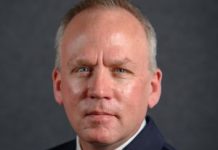Mike Miglio Podcast Transcript
Mike Miglio joins host Brian Thomas on The Digital Executive Podcast.
Brian Thomas: Welcome to Coruzant Technologies Home of The Digital Executive Podcast.
Do you work in emerging tech, working on something innovative? Maybe an entrepreneur? Apply to be a guest at www.coruzant.com/brand.
Welcome to The Digital Executive. Today’s guest is Mike Miglio. Mike Miglio is CEO and founder of DEIN. The decentralized marketplace for risk and insurance.
A seasoned entrepreneur with six years of experience. He previously served as founding partner of two of the world’s first cryptocurrency law firms, ICO Law Group and Wolf Miglio in 2017, guiding dozens of projects and exchanges through the uncertain legal landscape of the ICO era. In 2020, he launched his first Protocol Bridge Mutual.
Over the years, Mike has built and deployed protocols and projects with a combined market cap of 1 billion US dollars and has invested in or advised more than 50 other defi protocols across the crypto space. Most recently DEIN earned first place in the Amazon Prime TV series, crypto Nights for its innovation and ingenuity.
Good afternoon, Mike. Welcome to the show.
Mike Miglio: Thank you. Thank you for having me, Brian.
Brian Thomas: Absolutely my friend. I appreciate it. You’re in Puerto Rico? I’m in Kansas City. Love going international. I do most of my podcasts in North America, but I’ve done, uh, 54 countries now. So I appreciate you making the time. I know sometimes it’s difficult, so thank you.
And Mike, if you don’t mind, I’m gonna jump into your first question here. Rightfully, you’ve said that insurance is ultimately about trust. How is DEIN creating a decentralized trust layer that Defi markets can rely on?
Mike Miglio: Yeah, that’s right. So, right now DeFi is based, uh, almost entirely on, on reputation. So, for example, if a good VC backs it, if good exchanges launch a certain protocol, the protocols tend to attract, uh, traction and capital.
Whether or not it’s, it’s really deserved. What we are doing is transforming that, um, the deep, you know, defi into a, a transparent on chain market so people are able to put their money where their mouth is. If people believe that something is trustworthy, they underwrite it; it attracts capital. If people don’t believe that it’s trustworthy.
Uh, then their demand tends to be high and, uh, there is a high utilization ratio of the pool, which makes the cost of the insurance, uh, more expensive, but also makes the underwriting more rewarding for the underwriter.
Brian Thomas: Thank you. I appreciate that. And you’re right, trust goes a long way. And, and that’s why people like you get on a podcast, right?
People trust people, not necessarily companies. And I think that’s so important nowadays. And there’s always, sometimes a lot of hype initially about a particular. Uh, chain or, or a service that people, uh, are offering out there. So I appreciate your insights. And Mike, moving into the next question, DEIN’s marketplace model lets users determine coverage and pricing.
How do you maintain underwriting, discipline and capital stability in such an open system?
Mike Miglio: Yeah, that’s a broad and interesting topic. Basically there is no great way to currently, uh, price risk within DeFi protocols. We have very many different variables. You’ve got lots of different chains, coding languages.
We have, um, different. Stable coins underpinning different protocols, and if they were too deep pag, the protocols would, would unwind. Uh, there’s just so many things to consider and we only have about, I would say less than 10 good years of DeFi data and it’s not even organized. So, if you compare that to traditional, traditional insurance where you have certain fields with hundreds of years and like centuries of, uh, data.
For actuarial risk, uh, it’s, it’s very difficult to properly, uh, price these things. So, what we do is we open it up, we make it a free market, uh, all the different protocols within, um, defi, and in our case, we’re, we’re multi chain. So we, we cover every chain actually, and anyone can add any protocol. All of them have silo pools.
So, the capital is all distinct, uh, and doesn’t overlap. And all the claims are 100% collateralized. Uh, if, if, um. Oh, I forgot to mention we have a, uh, we have a, the way we price it is we have a. An equation that we created through our first protocol with years of data. So we had another protocol called Bridge Mutual, and we figured out how much people are willing to pay, right?
Um, but that looks like a bonding curve. So it goes, uh, it goes up sharply around 90% utilization, and the price gets really high up there. But underneath that 90% utilization ratio, the, uh, the price is quite reasonable. And so, people can look at the price, and they can decide if they want to buy it.
Um, and if the, there’s a lot of demand for a certain pool. The ratio will go high, like really high, like towards 90%, and that’ll increase their award for that pool and attract more liquidity. And that’s how it works. So, it’s a constantly evolving landscape on the markets on D inside with lots of different pools and ratios changing all the time, and the price updating in real time as well.
Brian Thomas: Thank you a lot to unpack, but I really appreciate that. And again, talk to a lot of, uh, guests on the show, uh, that are in this space as well. And it is sometimes hard to price, um, the risk, right? In these DeFi protocols. There’s so many data points to measure and there’s not a lot of historical data, as you mentioned, only about 10 years worth.
So I like how you are multi chain though. That’s important. Important to our, our listeners as well. But I like that, um, the pricing is, is, uh, updated regularly. It’s real time and, and trans, there’s transparency in there, so that’s, that’s really important to me. And Mike, as DN expands across more than 50 chains, what’s the biggest strategic challenge in scaling decentralized insurance globally?
Mike Miglio: Yeah, so we’re actually, we’re launching at 150 chains roughly. Uh, and we’ll keep adding them, right? So, the issue in the past has been that traditionally there hasn’t been insurance where people are interested in having it. Uh, as you know, DeFi Crypto it’s a hot market. Uh, new narratives come up.
People first they want some new chain and they want some Bitcoin layer two stuff, and they want to go back and, and focus on polygon. And BNB, uh, the, the, the flavor of the month kind of keeps things interesting and rolling. And for protocols that are like manually managed, uh, or insurance protocols that are manually managed, they can’t keep up, they can’t scale, they can’t keep shifting their focus and moving around their capital to keep up with the market.
That’s what makes DEIN so cool, is it is so modular and anyone can add any chain, add any protocol from any chain. We’ll have the newest and hottest products and a risk marketplace open for it within minutes of it launching. Right? The, the big, difficulty. The challenge is not a backend coding one because it’s all autonomous already.
We have it figured out that’s, that part is quick and easy and scalable. The harder part is optimizing the front end so that the users don’t feel inundated with over information and, uh, too many choices. And we, we try to put things that are of interest to the user. At the top of their, uh, dashboard because when you connect your wallet, uh, the protocol scans your wallet activity and it suggests things that are relevant to you.
So that’s, um, that will help quite a bit.
Brian Thomas: Awesome. I appreciate that. I, I like how, uh, it is so modular, as you mentioned, and flexible to connect to any chain, making it easy for consumers to access. Uh, and at the same time, you, you talked about, again, you, you, you got a, a new coin coming in, and there’s so much hype around it and people can’t keep up.
But, uh, I like how really, you’re just eliminating that noise, and you’re just, um, able to meet the consumer’s needs. So, I appreciate that. And then. Mike, what milestones need to be reached before decentralized insurance like DN can gain traction with traditional financial institutions and regulations?
Mike Miglio: Sure. So, the whole point of doing a decentralized protocol, in my opinion. Is to avoid all of the regulatory friction. Take out all the middlemen, make, basically make it direct from underwriter to policy buyer. And the only time anyone intervenes in the center is with the adjudicators. If there’s an active claim, if something has to be figured out.
Um. So that’s our goal. And we do want to, we do wanna move into traditional insurance, uh, as well. I think we’ll start with life insurance and, uh, real property insurance. I think those are the two probably easiest. And they’re not easy by any means. They’re daunting, they’re huge. Uh, but there is a lot of data for those things, and it’s, it’s.
Easier to prove that things happened in the real world when it comes to whether someone’s alive or dead, uh, or whether or not, you know, your house burned down or not. It’s, it’s less nuanced than things like car insurance, where it’s a lot of, he said, she said, and there’s no, no evidence and no proof, and you need like, onsite investigators and stuff.
Um, the first, the first step though, will, will be to launch the Dow. For, for those who are listening that don’t know what a DAO is, it’s DAO, it stands for decentralized autonomous organization. That word gets thrown around a lot. Um, there’s a lot of self-proposed DAOs out there that are not DAOs because they’re not actually decentralized nor autonomous.
They’re a small group of people that control the whole thing. And, um, that’s not what we’re talking about. In our case, what I’m talking about with Ardo. Is that you’ve got this, uh, code that exists as the DAO and the tokens control it. The tokens can vote on things, and as the tokens vote, whatever the outcome is, um, the, the code that was proposed gets enacted and the change gets made to the system.
And that’s what makes it, um, slippery in terms of regulatory friction and, and kind of cuts that out because, uh, even after we launch this thing, if regulators want to go and say like, Hey, you know, that’s, that’s, uh. What you’re doing there, like what your protocol does, it does that, that you created it, it’s, it’s doing regulated activity.
Um, and that, that may be true, but, uh, you can’t turn it off. You can’t, you can’t shut it down. Or at least I can’t, the, the token holders would have to all collectively vote to make a change or to shut it down or something like that. So that’s what, that’s what makes it really cool and unstoppable and interesting and scalable and and has a real shot at making a dent in traditional insurance.
Brian Thomas: I really love that, and that’s why I like Defi so much. Our publication’s actually built on blockchain as well, so pretty exciting. But I like how you are looking to move into traditional insurance, uh, that space. Maybe the, um, not traditional, but uh, life and property. Um, there’s lots of data, uh, behind that.
Of course, in those industries, easy to prove in MVP. But, um, what I really liked and I took away, and I think mad is gonna love this, is the, your explanation definition of a dao. And I think it’s so important that we have true DAOs and that term is thrown out around pretty loosely, quite a bit, and a true DAO uh, ensures that there is long term, uh, sustainability and, and transparency, uh, in this particular realm of the world, which we all love.
So thank you. And Mike, the last question of the day. What does success look like for DEIN? Give me a window into the roadmap for the next, about a few years.
Mike Miglio: Yeah, sure. So the, the first thing would be to transition governance fully, uh, to the community so that, like I said, it can’t be, uh, taken down. All we’ll have is access and control over the front end, but hopefully people will create many front ends to our, to our backend, you know, system of smart contracts that creates this decentralized insurance network.
And then expanding the products and, and the scope to many things beyond just, you know, defi on chain. Coverage too. Like I mentioned, real estate, uh, insurance and then health insurance and then life insurance, energy, weather, other things like that. And then eventually success would mean DEIN becoming the, the trust backbone of just, not just defi, but, but risks at large.
Every, every protocol, every asset, you know, chains carrying verifiable risk scores, powered by DEIN markets and metrics that are created by our free markets people, you know, buying and selling and trading risk, um, ends up being a truer. Uh, metric to accurately assess risk, then audits, for example, or then news publications or whatever.
And in that sense, it’s very similar to like poll market, right? And, and, and these two things are very similar also, like insurance and predictions, uh, insurance being essentially a prediction market where you have to prove a loss and you get made whole, right? It’s not that much different. But what’s cool is like you can, you can see what the world really thinks.
Via poll market, um, and the polls because people put their money where their mouth is and typically they, they tend to be right, or if they’re not, the market’s just very quickly. And it’ll be the same for insurance. Like if there’s, um. A big scare with hyper liquid, for example, which is a very big app right now with a few hundred million, uh, locked in value.
Uh, if there’s a scare, you’ll see the, the demand jump up and the price go up and, and, and it’ll reflect like more accurately what the true risk of having your capital on hyper liquid is. And then I think very long term to wrap that up. Uh, my, my dream would be that there are thousands of claims happening on DEIN every single day, and the people who are, uh, token holders who have staked their tokens and are vo on these claims and getting paid to adjudicate claims as rewards, this becomes like their job.
They become part of the decentralized network by owning some of these tokens. And these tokens represent a chunk of their net worth. But it also is a thing that allows them to have access to the system and continue to, uh, work and earn income on chain. And they basically, like they invest into their job and their job bring them, brings them back rewards.
And it’s all like that. There’s no employer, there’s no, again, no middleman. It’s just they’re part of the system and. That’s, that’s a great opportunity I think for people like in second and third world countries, um, where the reward amount is actually a significant sum for, for them, for where they live.
So that’s the, that’s the idea.
Brian Thomas: That’s pretty cool. Really like that, you know, token owners and the community becoming part of DEIN ecosystem, so to speak, right? I think that’s pretty cool. Um, but I like your vision expand into all areas of insurance. I think it’s bold, yet visionary, and I, I really think you could become the premier defi insurance platform of choice.
Um, so I really appreciate everything that you’ve shared today and it was such a pleasure to have you on, Mike, and I look forward to speaking with you real soon.
Mike Miglio: Yeah, as we wrap up, I’ll just mention, um, DEIN.fi, DEIN.fi is our website. Uh, you can check us out on, X and Telegram. Uh, DEIN.fi is our handles for those things.
Uh, keep up with us and we launch soon. I think it’s gonna be quarter one of this coming year, which is, uh, 2026. So keep, uh, keep an eye out.
Brian Thomas: Thank you. Bye for now.
Mike Miglio Podcast Transcript. Listen to the audio on the guest’s Podcast Page.











